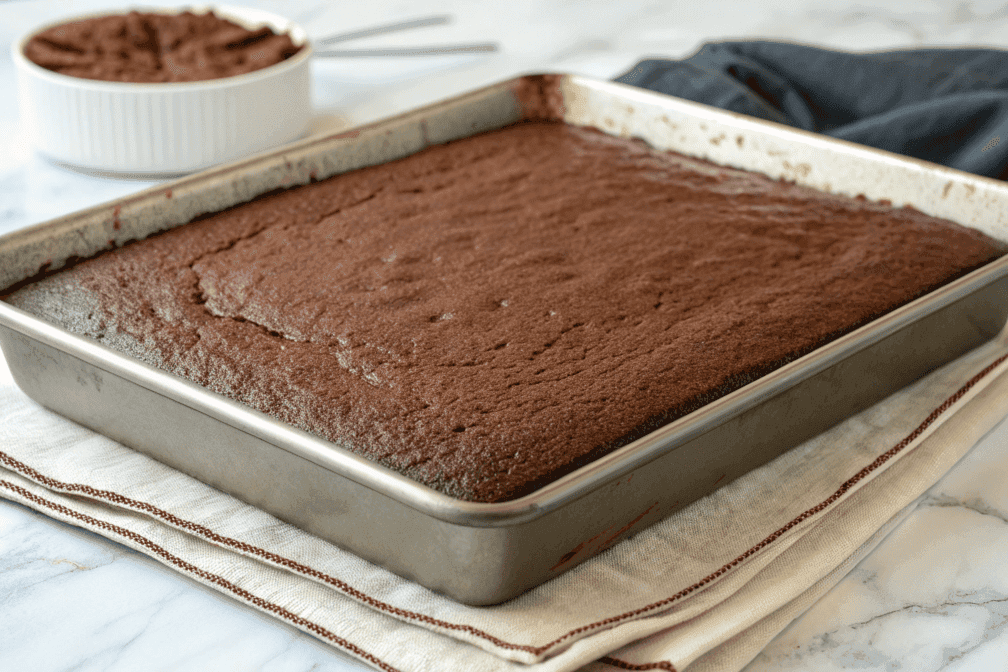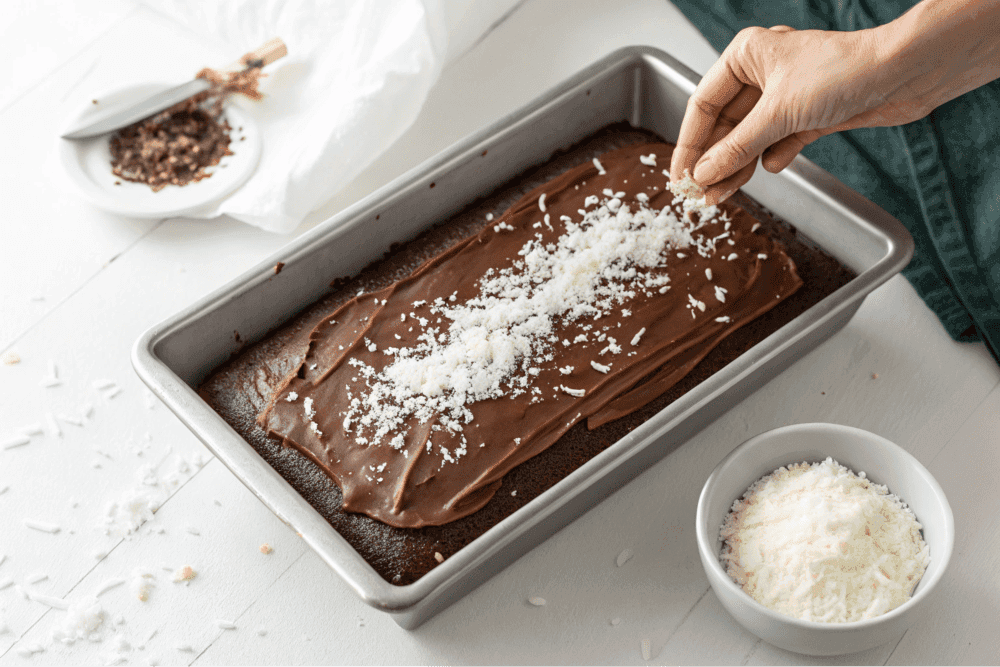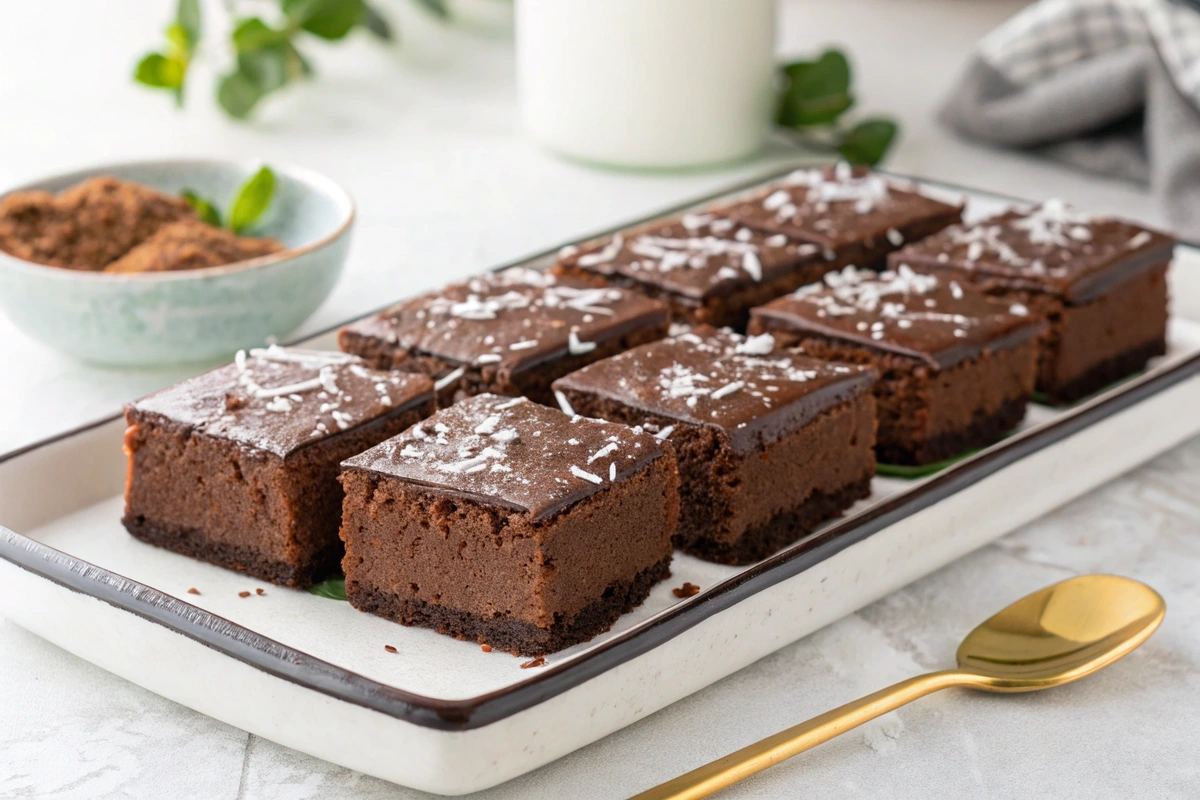Kefir sheet cake is the ultimate fusion of simplicity and flavor—a dessert you’ll keep coming back to. The Easy Kefir Sheet Cake Recipe Card brings together a moist texture, tangy undertones, and rich chocolate glaze, making it perfect for any occasion, whether casual or festive. In this article, we’ll guide you through everything you need to know: the benefits of using kefir in baking, a detailed recipe, tips for success, and creative variations. Let’s dive in and discover why this probiotic-rich, tangy delight deserves a spot in your recipe book.
Introduction to Kefir Sheet Cake
What is a Kefir Sheet Cake?
A kefir sheet cake is a delightful dessert that brings together the rich tanginess of kefir and the moist, fluffy texture of a traditional cake. Kefir, a fermented dairy product packed with probiotics, acts as a star ingredient, offering a unique twist to this easy-to-make treat. Think of it as the perfect blend of health benefits and indulgence.
Why Choose Kefir for Baking?
Why kefir? Well, it’s not just about flavor—it’s also about achieving the perfect bake. Kefir’s acidity interacts with baking soda, creating a light and airy crumb that’s hard to resist. Plus, it adds a subtle tang that balances the sweetness of the cake. Whether you’re a seasoned baker or a newbie, kefir simplifies the process and elevates the outcome.
What Does Kefir Do in Baking?
Kefir, a tangy and nutrient-rich fermented dairy product, is a game-changer in baking. Its unique properties enhance both flavor and texture, making it a versatile addition to many recipes.
Overview of Recipe Simplicity and Benefits
This recipe is as straightforward as it gets. Using simple pantry staples and minimal prep time, you can whip up a dessert that’s both impressive and effortless. Beyond its ease, the kefir sheet cake offers a healthy spin on indulgence, thanks to kefir’s protein, calcium, and vitamins. Ready to explore? Let’s get started with the ingredients and steps to create your own tangy masterpiece.
Does Cooking with Kefir Destroy Probiotics? Understanding the Impact of Heat
Cooking with kefir does destroy its probiotics. Probiotics, the beneficial live bacteria in kefir, are sensitive to heat and begin to die off at temperatures above 115°F (46°C). This means that baking, boiling, or frying with kefir eliminates its probiotic content.
Despite this, kefir still offers significant benefits when used in cooking. Its tangy flavor and creamy texture enhance recipes like pancakes, breads, and sauces, much like buttermilk or yogurt. Moreover, while the probiotics are lost, kefir remains rich in protein, calcium, and essential vitamins, making it a nutritious addition to your meals.
To preserve the probiotics, use kefir in uncooked recipes such as smoothies, salad dressings, or dips. Alternatively, add it to warm dishes only after they’ve cooled slightly. This way, you can enjoy both its flavor and its health-promoting properties.
Ingredients for the Perfect Kefir Sheet Cake
Basic Ingredients for a Moist and Tangy Kefir Cake
Creating an Easy Kefir Sheet Cake Recipe Card starts with simple, accessible ingredients. The batter requires basic pantry staples that you probably already have. You’ll need all-purpose flour, granulated sugar, baking soda, and unsweetened Dutch cocoa powder for the structure and flavor of the cake. For the liquid base, kefir takes center stage, providing the signature tang and moisture. You’ll also need a medium egg, oil (sunflower or canola works well), and a touch of salt to balance the flavors.
Kefir: The Star Ingredient – Variants and Substitutes
Kefir is the game-changer here, offering a unique tanginess that distinguishes this cake. Not only does it enhance flavor, but it also contributes to the cake’s tender crumb by activating the leavening agents. If kefir isn’t available, don’t fret! You can substitute it with buttermilk or plain yogurt in a 1:1 ratio, though the flavor profile might differ slightly.
For adventurous bakers, try experimenting with flavored kefir like vanilla or strawberry for a creative twist. These variations can add depth while keeping the recipe easy and approachable.
Chocolate Glaze and Optional Toppings
No cake is complete without a delectable topping! For the glaze, use semi-sweet or dark chocolate chips melted with heavy cream to create a smooth, glossy finish. Finally, sprinkle unsweetened shredded coconut for added texture and visual appeal. Want more customization? Add chopped nuts, fresh fruits, or a drizzle of caramel for a unique touch.
This simple yet rich combination of ingredients ensures that your Easy Kefir Sheet Cake Recipe Card is not only delicious but also adaptable to your preferences.
Step-by-Step Guide to Making Kefir Sheet Cake
Prepping for the Perfect Tangy Sheet Cake
Before you start, gather all the tools and ingredients to streamline the process. You’ll need a 9×13-inch baking sheet, mixing bowls, and a whisk or electric mixer. Preheat your oven to 340°F (170°C), and grease the baking sheet with oil. To prevent sticking, dust it with breadcrumbs or flour—a small but essential step for a flawless bake.
Mixing the Batter: Tips for the Right Consistency
In a large mixing bowl, combine the kefir, oil, sugar, cocoa powder, and egg. Mix gently until the ingredients are well-blended. Then, gradually add the flour and baking soda, stirring carefully to avoid lumps. Be sure not to overmix; otherwise, the cake’s texture could become dense. The batter should be smooth and slightly thick, perfect for creating a light and moist crumb.
Baking and Decorating Your Kefir Sheet Cake
Pour the prepared batter into the greased baking sheet, spreading it evenly with a spatula. Place it in the preheated oven and bake for 20–25 minutes. Use a toothpick or skewer to test for doneness—if it comes out clean, your cake is ready. Let it cool completely on a wire rack before adding the glaze.

Decorating with Glaze and Coconut
While the cake cools, prepare the chocolate glaze. Melt the chocolate chips in a double boiler, then stir in the heavy cream until the mixture is smooth and glossy. Spread the glaze evenly over the cooled cake using a spatula. Finally, sprinkle shredded coconut across the top for a finishing touch that’s as tasty as it is beautiful.

By following these simple steps, your Easy Kefir Sheet Cake Recipe Card will deliver a show-stopping dessert that’s both easy to make and irresistibly delicious.
Benefits of Kefir in Baking
Enhanced Flavor Profile from Kefir
One of the best reasons to bake with kefir is its ability to boost flavor. The tangy and slightly sour profile of kefir adds complexity to sweet treats like the Easy Kefir Sheet Cake Recipe Card. Unlike plain milk or water, kefir brings a richness that complements chocolate, vanilla, or even fruit-infused recipes. Its unique flavor is subtle enough not to overpower but distinct enough to stand out.
Kefir’s Contribution to Moisture and Texture
Texture is everything in a great cake, and kefir delivers in spades. Its acidity reacts with baking soda, creating a soft, fluffy crumb. Cakes baked with kefir tend to stay moist longer, ensuring every bite is as delightful as the first. If you’re tired of dry desserts, this ingredient is your solution.
Health Advantages: Probiotics and Nutritional Value
Though some probiotics are lost during baking, kefir still provides an edge. It’s rich in calcium, protein, and essential vitamins, making your dessert a tad healthier. Using kefir can even serve as a gentle introduction to probiotics for those new to fermented foods.
For more delightful desserts, check out The Best Madeline Cookies Recipe Using Cream for another creamy indulgence.
Storage, Serving, and Customization Tips
Best Practices for Storing Kefir Sheet Cake
To keep your Easy Kefir Sheet Cake Recipe Card fresh and flavorful, proper storage is essential. Once cooled, wrap the cake tightly in plastic wrap or store it in an airtight container. This prevents the cake from drying out. If you plan to enjoy it over a longer period, consider freezing individual slices. Wrapped well, the cake stays good for up to two months in the freezer.
Serving Suggestions for Every Occasion
Whether you’re hosting a casual brunch or an elegant dinner, kefir sheet cake fits the bill. For a rustic vibe, serve it with a dollop of whipped cream and fresh berries. Hosting a formal gathering? Add a drizzle of caramel or a sprinkle of edible gold dust for a fancy touch. No matter the setting, this cake’s tangy base and rich glaze always steal the show.
Creative Variations: Adding Fruits, Nuts, or Layers
Take this versatile recipe to the next level by adding your personal twist. Mix chopped nuts or dried fruits into the batter for a burst of flavor and texture. Want to make it extra special? Split the cake horizontally and add a thin layer of jam or cream filling. Your creativity is the only limit!
Common Mistakes to Avoid When Using Kefir
Overmixing the Batter and Its Consequences
A common pitfall when making the Easy Kefir Sheet Cake Recipe Card is overmixing the batter. While it might seem like a good idea to ensure everything is thoroughly combined, overmixing can actually make your cake dense and chewy instead of light and fluffy. Remember, once the dry ingredients are added, mix only until the lumps disappear to maintain the ideal texture.
How to Handle Kefir Correctly in Baking
Another mistake is mishandling kefir itself. Since kefir is a live, fermented product, it’s sensitive to heat. Always store it in the fridge until you’re ready to use it. Using expired or spoiled kefir can lead to unpleasant flavors, so check for signs like sour smells or discoloration. For substitutions, stick to buttermilk or yogurt, as other liquids may not react well with baking soda.
Substitute Errors and How to Prevent Them
Substituting kefir improperly can compromise the taste and texture of your cake. While buttermilk and yogurt work as great stand-ins, avoid using milk or cream alone—they lack the acidity that kefir brings. Additionally, measure your ingredients carefully. Precision ensures your cake turns out just right, every single time.
nutritional breakdown for one square (approximately 60g) of Kefir Sheet Cake:
| Nutrient | Amount per Serving (60g) |
|---|---|
| Calories | 190 kcal |
| Carbohydrates | 25 g |
| Protein | 4 g |
| Fats | 8 g |
| Fiber | 1 g |
| Sugars | 15 g |
| Calcium | 50 mg |
| Iron | 1 mg |
| Vitamin A | 2% of Daily Value |
| Vitamin D | 5% of Daily Value |
| Vitamin B12 | 4% of Daily Value |
FAQs About Kefir Sheet Cake
What Not to Do With Kefir ?
When using kefir, avoid leaving it at room temperature for too long, as it can over-ferment and spoil quickly. Additionally, don’t use metal utensils, since kefir’s acidity may react with metal, affecting its taste and quality. Moreover, never overheat kefir, as high temperatures destroy its beneficial probiotics. Finally, always check for allergies or intolerances to ensure it’s safe for everyone to enjoy.
How to Make the Recipe Gluten-Free?
Turning this cake into a gluten-free version is simpler than you think. Swap out all-purpose flour for a gluten-free baking blend that includes xanthan gum or another binding agent. Be sure to sift the flour thoroughly to avoid any clumps, ensuring a smooth, light batter.
How to Tell if Kefir is Bad ?
To tell if kefir is bad, start by checking its smell—if it’s overly sour or rancid, it’s likely spoiled. Additionally, look for changes in texture, such as excessive clumping or sliminess, which indicate it’s no longer safe to consume. Moreover, unusual colors like pink, green, or brown, or the presence of mold are clear warning signs. When in doubt, it’s better to discard it than risk consuming spoiled kefir.
Does Cooking with Kefir Destroy Probiotics?
Cooking with kefir does destroy its probiotics. Probiotics, the beneficial live bacteria in kefir, are sensitive to heat and begin to die off at temperatures above 115°F (46°C). This means that baking, boiling, or frying with kefir eliminates its probiotic content. Despite this, kefir still offers significant benefits when used in cooking. Its tangy flavor and creamy texture enhance recipes like pancakes, breads, and sauces, much like buttermilk or yogurt. Moreover, while the probiotics are lost, kefir remains rich in protein, calcium, and essential vitamins, making it a nutritious addition to your meals. To preserve the probiotics, use kefir in uncooked recipes such as smoothies, salad dressings, or dips. Alternatively, add it to warm dishes only after they’ve cooled slightly. This way, you can enjoy both its flavor and its health-promoting properties.
Conclusion and Final Tips
Why Kefir Sheet Cake is the Ultimate Tangy Treat
The Easy Kefir Sheet Cake Recipe Card is a must-try for anyone who loves combining simplicity with exceptional flavor. Its tangy base, moist texture, and glossy chocolate glaze make it a dessert that’s both easy to prepare and hard to forget. Whether you’re baking for a special event or a quiet night at home, this cake delivers every time.
Final Tips for Perfecting Your Tangy Kefir Cake Recipe
Don’t hesitate to make this recipe your own! Add a layer of jam, try different toppings, or use flavored kefir for a unique twist. The possibilities are endless, and the results are always delicious.

